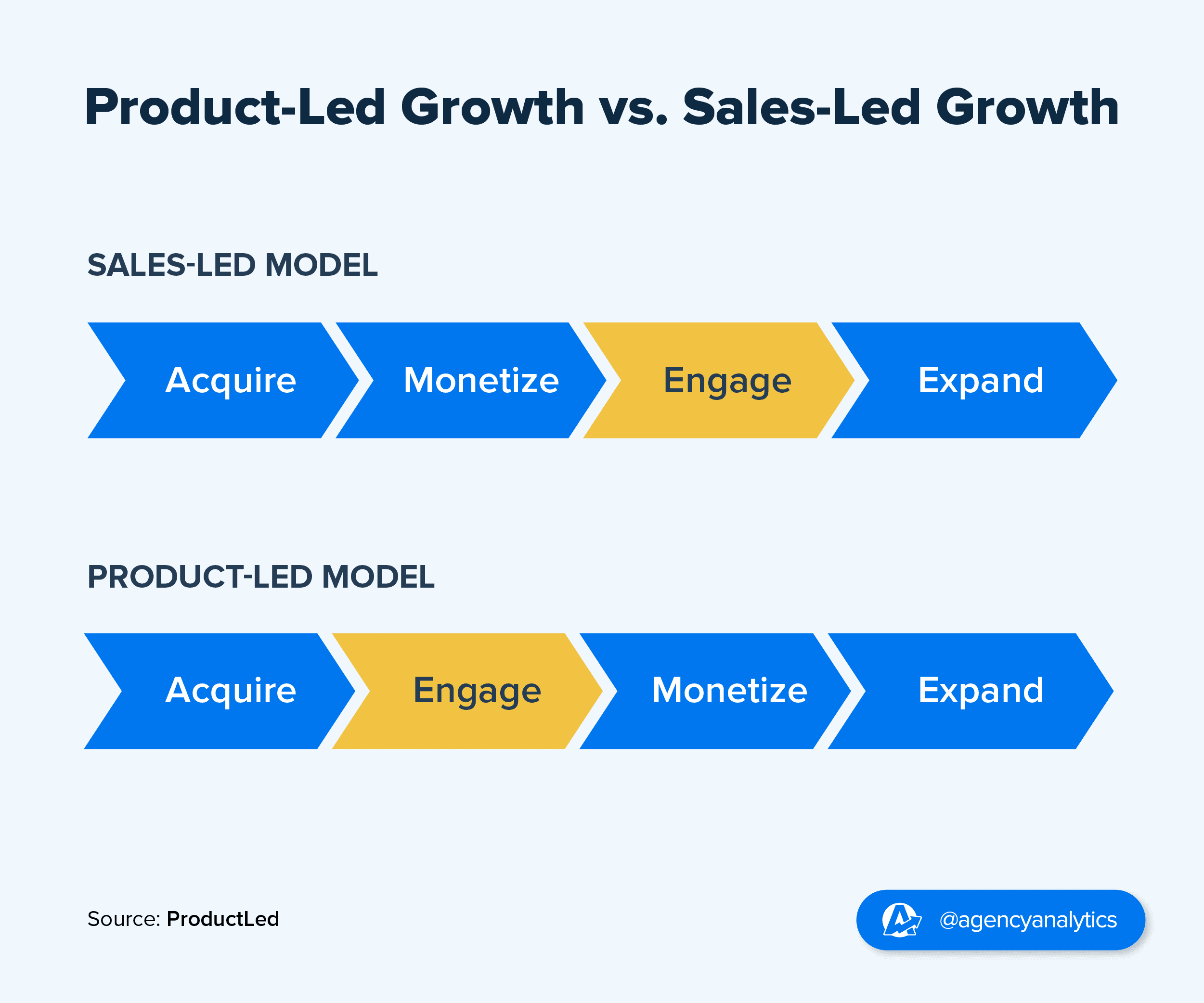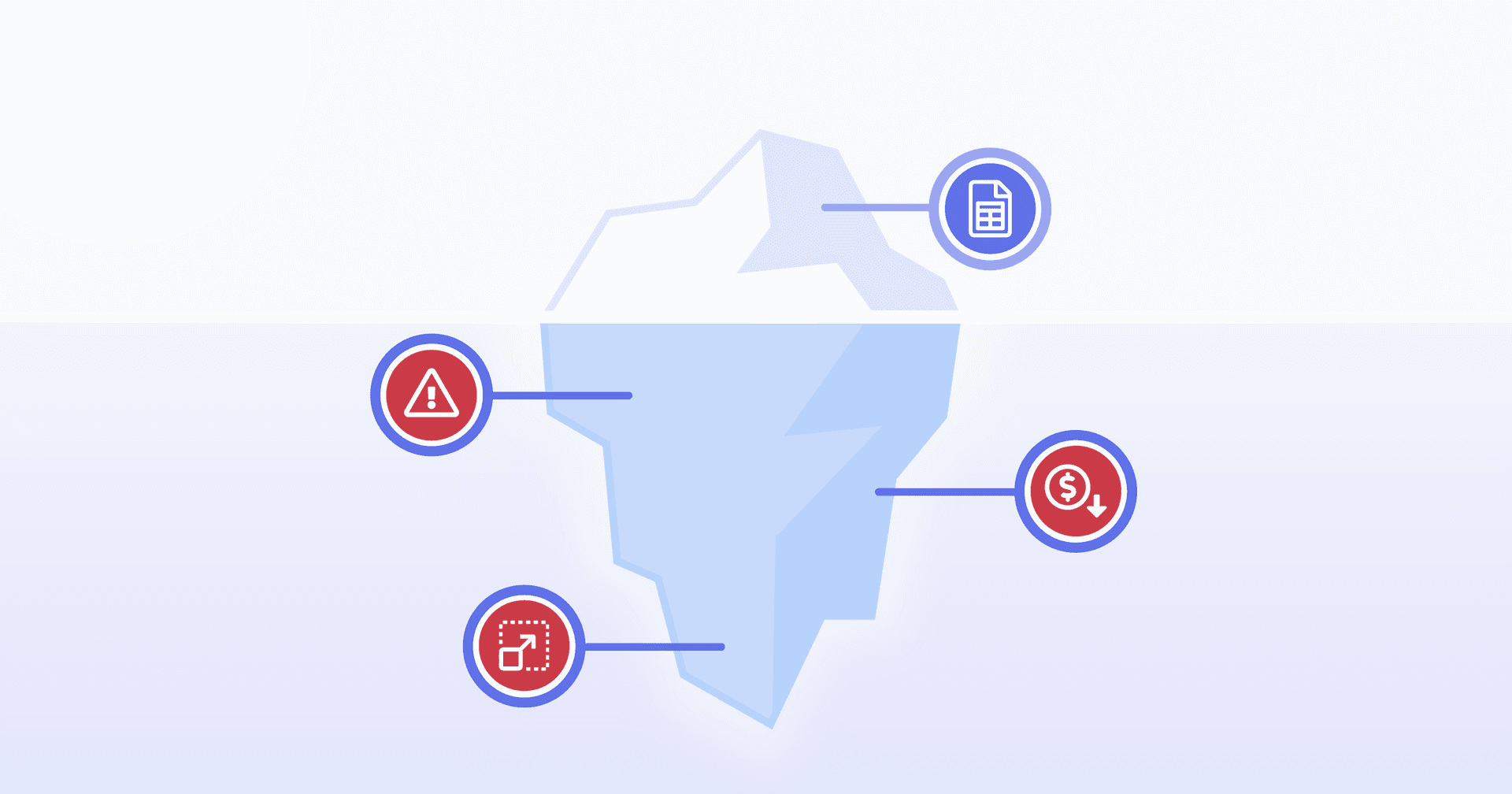Table of Contents
QUICK SUMMARY:
Tech companies are starting to shift how they market themselves, opting for a Product-Led Growth strategy that relies on a well-built product to increase customer acquisition and long-term revenue. This strategy encourages all departments to collaborate together with one common philosophy—the product comes first. In this article, we’re sharing how marketing agencies are using PLG strategies to enhance client outcomes.
Marketers in the SaaS sphere are seeing profound change as companies begin to pivot from a sales-centric mindset to embrace Product-Led Growth (PLG) strategies.
As customer expectations continue to change, more tech startups are starting to bypass the sales cycle entirely. Instead of targeting top decision makers at large enterprises and waiting months for a deal, many SaaS businesses are opting to focus on the end user, providing free versions of intuitive, user-friendly products to increase revenue growth.
A recent survey of over 600 B2B SaaS companies found around 58% of those surveyed already had a Product-Led Growth plan in motion.
For agencies, this shift is leading to a complete overhaul in how marketers think, plan, and execute their strategies.
Today, we’re sharing everything you need to know when working with a PLG-oriented client.
Product-Led Growth Explained
Product-led companies focus on creating a well-built product that will drive customer acquisition and engagement, encourage retention, and lead to monetization.
This strategy changes the customer journey and takes the focus off of marketing and sales teams to find and convert leads. Instead, it centers on creating an amazing product that users can try out for free through a freemium or free-trial revenue model.
Once potential customers are hooked, they then convert to a paid version and, with any luck, tell all their friends and colleagues about it, leading to exponential growth.
This is known as product-led sales.
How Product-Led Growth Affects Customer Acquisition and Retention
Product-led companies are based on the idea that building a good product—and sharing it for free—will help acquire customers, generate demand, and increase retention at a much lower cost.
When it comes to managing customer acquisition costs, it's important to look at all parts of the new client sales funnel, because each stage can have an impact on the cost of acquiring a new customer.
Ken Krystofik, Head of Client Development, Intellisea
In a traditional sales-led strategy, the average customer acquisition cost (CAC) is about $702 for the SaaS industry. This is mostly due to the amount of time and effort it takes to get a sale. But by allowing users to test a product for free without having to go through a lengthy sales cycle, Product-Led Growth models end up converting more customers at a lower cost.
This strategy also leads to increased customer retention. Not only are customers seeing a faster Time to Value for their money, they’re also using a refined, well-made product that has been customized to meet their exact pain points. In the end, a better product almost always leads to happier customers.
The Difference Between Product-Led Growth and Sales-Led Growth
Product-Led Growth is vastly different from the traditional sales and marketing led growth model for a variety of reasons, including:
Target Audience
The Product-Led Growth strategy focuses on the end user while Sales-Led Growth targets top decision makers in the field. For example, a product-led company selling invoicing services may concentrate on accountants or small business owners while a sales-led company would appeal to CFOs.
Customer Acquisition Model
In a Sales-Led Growth model, the sales team attracts leads, converts those leads into customers, ensures customers are engaged with the product, then expands or upsells. In this strategy, the customer doesn’t get to experience the product until the third step.
In a Product-Led Growth model, a company first acquires leads, then lets those leads engage with the product through a free-trial or freemium program, then monetizes and expands.

Understanding the Product-Led Growth Revolution
Product-Led Growth is a relatively new go-to-market strategy that was inspired by customer demand and rising competition in the tech and SaaS field.
The History Behind Project Led Growth
Let’s look at a timeline of how PLG came to be a prevalent growth strategy.
Timeline | Stage | Description |
|---|---|---|
1980s-1990s | Field Sales Was King | During this time, sales-led companies were the norm and typically focused on enterprise sales. Software purchases were seen as significant investments promoted primarily by the sales team. Decisions were made by senior IT leaders and the sales cycle was typically very long. Field sales was the best way to score a contract. Sales reps would travel for in-person meetings and spend time building relationships with these leaders. |
2000-2010 | The Rise of Inbound Marketing | As cloud-based SaaS subscriptions became popular, sales teams focused on top executives in each department, with marketing efforts going towards building brand and customer loyalty. These execs often did their own research and had less patience when it came to the sales time. Sales and marketing departments started working side-by-side as inbound marketing became popular. Growth teams still focused on the brand over the product. |
2010s-Current | The Emergence of Product-Led Growth | Instead of focusing on top decision makers and depending on a company's sales team, smaller tech and SaaS startups started selling to the average user. And it started a revolution. Rather than forcing clients to talk to sales, book a demo, pay for the product, then use it, some growth teams simply made their products available to all users in a limited capacity through a product-led sales model. Then, if the average user liked it enough, they invested in the paid version. This strategy forced tech businesses to build better, more intuitive products while handing the reins to the end user and enjoying a lower customer acquisition cost. |
Companies That Thrived Using Product-Led Growth
In 2013, a small B2B tech product made history using product-led sales.
After only eight months in the market, Slack reached a $1 Billion valuation, making it the fastest-growing SaaS startup in the industry at that time. This was accomplished without spending any money on traditional advertising.
Instead, the company spent years testing and perfecting their product internally before launching publicly.
While Slack is an impressive example of Product-Led Growth’s potential, it’s not the only one. Other Product-Led Growth success stories include:
Calendly, a scheduling platform that reached a $3 billion valuation by launching a freemium model first before adding a premium version in 2014.
Shopify, which is known worldwide as one of the most popular ecommerce platforms, with an 11% market share. The company uses a product-led approach, remaining focused on improving its product and offering a free trial period.
The Ins and Outs of Product-Led Growth Strategies
While no two Product-Led Growth models will look alike, they all share a number of common factors. From free-to-use options aimed at end users to creating a customer-centric focus that drives client acquisition and retention, product-led models follow several fundamental guidelines.
The Key Principles of a Successful Product-Led Strategy
PLG strategy has a number of tenets that hold true, regardless of the company. Let’s take a closer look:
Prioritizing the Product Above All Else
A product-led strategy centers around building a seamless customer experience. Companies build well-designed products that meet the customer’s expectations, and make changes based on user behavior.
Focus on Client Needs
In product-led organizations, there are no siloed departments. Instead of having the sales team own client acquisition, every team collaborates with each other to build and share a superior product.
This will look different for every department. Product-led marketing teams may ask, “How can we position our product so customers try it out?” while product-led customer success teams would ask, “How can we empower the customer to solve their problems on their own?”
User Centric Designs
A product-led company creates intuitive, easy-to-use platforms with in-app tutorials that allow users to completely sign up, upgrade, and use the product on their own.
Customer Acquisition Through Free Models
In a product-led approach, clients don’t have to ask for a demo to use the platform or software. Product-led companies provide freemium or free trial options to get buy-in and convert users into paying customers. This often leads to lower customer acquisition costs.
Build It and They Will Convert
In a traditional strategy, a sales rep would typically focus on enterprise buyers, with products fitting into the enterprise software category.
From white papers to high-touch presentations led by the sales team, traditional strategies relied on a variety of techniques to attract and retain customers.
PLG companies rely on just one:
Building a really good product that people love to use.
While both methods require significant time and financial investments, product-led platforms tend to have a faster time to value. By making the product accessible and easy to use, companies like Slack and Calendly put the power back into the customer’s hands.
This business model often leads to increased customer attraction and, if the product is good enough, high retention rates.
According to a recent survey of over 600 SaaS businesses, the conversion rate for freemium customers was 3 times higher when using Product Qualified Leads (PQLs), which identify potential customers based on how they interact with the product (more on this later).
How Customer Success Fits Into Product-Led Strategies
Customer Success (CS) is traditionally a high-touch role centered on managing key client relationships both pre and post sales.
When looking at a Product-Led Growth model, a customer success team plays an entirely different role. Instead of being up front and center, the CS team steps back, allowing each customer to onboard on their own, providing support when needed.
With product-led companies, CS’s job is to create a seamless self-serve process. This includes creating in-app tutorials, providing self-help resources, and identifying opportunities to upsell.
At AgencyAnalytics, our customer success team is committed to providing seamless support to our more than 7,000 agency customers. Learn more about why we’ve been awarded a 4.7 G2 rating by signing up for a free 14-day trial today.
Common Product-Led Growth Models
Product-led companies typically use two frameworks when acquiring customers:
1. Freemium
This model allows users to try out the product for free indefinitely at a reduced capacity. There are 3 types of freemium frameworks PLG companies use.
Models include:
Those that reduce features. For example, Canva allows anyone to access their graphic design platform, but only paid subscriptions access premium features like unlimited templates.
Those that reduce usage. Landbot is a popular no-code chatbot builder with a free option that only allows 100 chats per month.
Those that reduce access to support. For example, a freemium plan may include email support only, but exclude telephone or chat support.
2. Free Trials
There are usually 2 types of free trial options PLG companies use:
Opt-in models
This option lets users try a product for free for a limited time. Opt-in models allow for easy sign-up and let customers leave without needing to cancel their accounts at the end of the trial period. Shopify does a great job of this, offering a 3-day free trial without asking for credit card information. Once the free trial is done, customers can pay $1 a month for 3 months.
Opt-out models
With this option, customers need to input their credit cards before accessing a free trial. While this leads to fewer users, it also has a higher conversion rate than the opt-in version at 60% conversions versus 25%. Amazon Prime is one of the PLG companies using an opt-out model. Users are required to enter their credit card info to access the free trial.
How the Product-Led Funnel Works
Building and tracking a product-led funnel looks different than the traditional sales-led model. While Marketing Qualified Leads (MQLs) are tracked based on how often people interact with the brand, Product Qualified Leads are based on how users interact with the product.
What Are PQLs?
PQLs are based on users who show strong engagement with a company’s product and are likely to convert to a paid model.
For example, let’s say your client launched a social media scheduling app that has 3000 users signed up for the freemium version.
200 of these users log in several times a day, are more likely to find and try out new features, and make use of a wide range of platform capabilities. These 200 users have already found value from your client’s product and would be seen as ideal PQLs that can be more easily converted to a paid subscription to encourage revenue growth.
It's all about moving these prospects down the sales funnel–not as quickly as possible, but as efficiently as possible.
Brian Lozano, Vice President of Operations, Ad-Apt
How PQLs Encourage Growth
While MQLs are handled primarily by the marketing team or agency, PQLs are shared with the product team. Together, these teams track product usage analytics and product-related behaviors such as feature adoption.
To track and leverage PQLs, agencies typically use the following process:
Step 1: The agency and product teams will establish PQL criteria. This should include product analytics that track activation and engagement.
Step 2: Divide users into categories to better understand which users qualify as PQLs. Category examples include:
Evaluators | Users interested in some features to solve a specific problem. |
Beginners | Users who know the product can help and invest time to learn. |
Regulars | Users who often use core features and are interested in expanding. |
Champions | Users who recommend the client’s product. |
Step 3: The product team works with the agency to find patterns and determine how to optimize the customer lifecycle.
Step 4: Insights are turned into experiments. For example, if you found that champions have higher retention rates when converted to paying customers, your agency could create a referral campaign targeted to this category.
Tracking Time To Value
Time to Value is one of the most important metrics in any Product-Led Growth strategy. PLG companies use it to determine how likely users are to convert. Time to Value is the time it takes for new users to fully appreciate a product’s value.
In our social media app example, the Time to Value timeline may look something like this:
A potential customer wants to build their thought leadership credentials by posting on several different social media channels. They register on your client’s platform for a 14-day free subscription. Their goal is to post faster and increase efficiency.
The customer goes through the seamless self-serve onboarding process and starts scheduling posts through the product’s easy-to-use interface.
The customer starts trying out new features, like automated scheduling and post analytics.
The customer reaches Time to Value. They are successfully creating, scheduling, and analyzing their social posts quickly and efficiently.
The customer converts to a paid model when the free trial is over.
Customer satisfaction is ultimately the goal of a great partnership. All other metrics are secondary.
James Shaw, Creative Director, Twin Creek Media
How Usage and Engagement Fits Into the Product-Led Puzzle
Usage and engagement are two key metrics in a product-led model. These data points identify user satisfaction and the product’s overall value.
When tracking these metrics, you’re looking at the level of interaction and the amount of value end users are getting out of a product. High user engagement and usage leads to increased growth and better customer retention rates.These indicators are tracked by:
Adding tracking mechanisms to different features. This provides insight into how users are interacting with a product and identifies which features are underused.
Heat maps and session recordings, which monitor behavior and identify which features show high engagement levels.
User surveys, which provide better understanding of how customers are finding value in a product.
By tracking these metrics, product-led companies better understand how to optimize their product to achieve faster Time to Value.
For further context, let’s use the social media scheduling app as an example.
Let’s imagine that the development team wants to track engagement and usage by adding tracking mechanisms to 3 key features–scheduling, editing tools, and post analytics. They noticed users all try the editing tools but don’t spend as much time on them as the other features and eventually stop using them altogether.
After investigation, the product team identifies that the tools aren’t intuitive enough and are blocking Time to Value. This feature is optimized, leading to higher usage rates and increased customer retention.
Putting the Product First
Product-Led Growth has become a necessity for an increasing number of tech companies trying to compete in an ever-changing market, enhance the customer journey, and increase customer lifetime value. While a traditional sales team might focus on selling the brand through email marketing and other outbound strategies, this business strategy puts the product first, creating a well-built product that converts leads and changes the customer journey.
When your agency is working with product-led businesses, it’s essential to create impactful reports that emphasize the results of your strategic marketing efforts. AgencyAnalytics allows agencies to seamlessly build personalized, automated reports that track PQLs, MRR, Churn, and other key Product-Led metrics.
Sign up for a 14-day free trial and start creating top-tier customer reports for your PLG clients today.

Written by
Rita Poliakov is an experienced content writer with a knack for storytelling. As a former journalist, she's a skilled researcher, interviewer, and grammar nerd.
Read more posts by Rita PoliakovSee how 7,000+ marketing agencies help clients win
Free 14-day trial. No credit card required.





